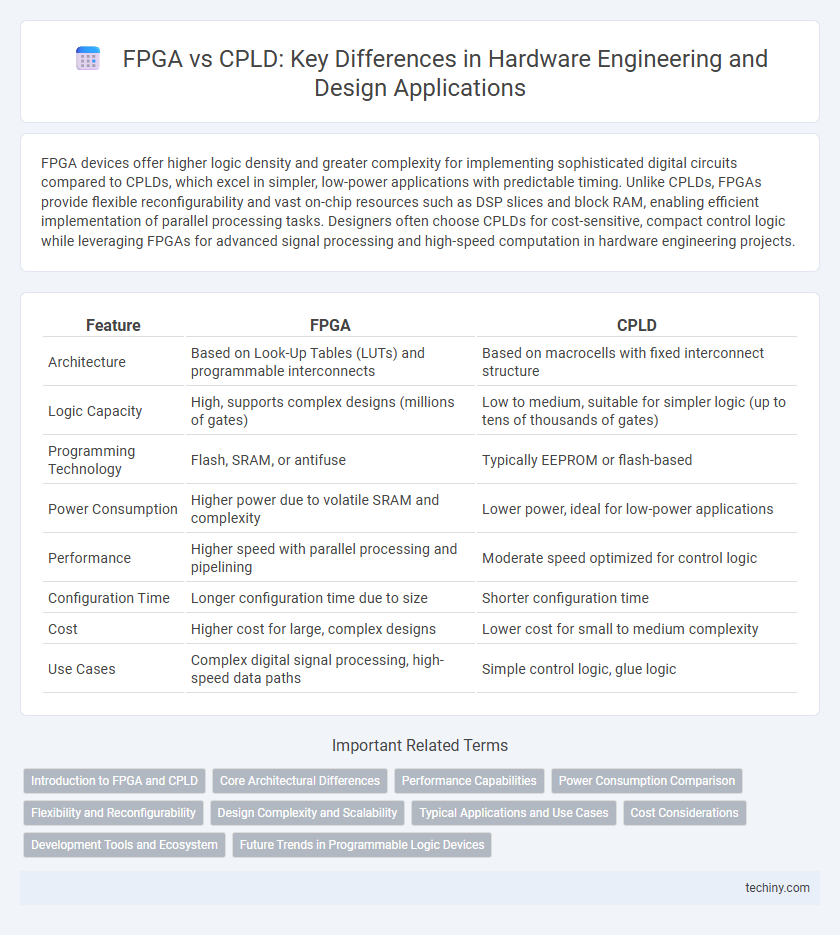FPGA devices offer higher logic density and greater complexity for implementing sophisticated digital circuits compared to CPLDs, which excel in simpler, low-power applications with predictable timing. Unlike CPLDs, FPGAs provide flexible reconfigurability and vast on-chip resources such as DSP slices and block RAM, enabling efficient implementation of parallel processing tasks. Designers often choose CPLDs for cost-sensitive, compact control logic while leveraging FPGAs for advanced signal processing and high-speed computation in hardware engineering projects.
Table of Comparison
| Feature | FPGA | CPLD |
|---|---|---|
| Architecture | Based on Look-Up Tables (LUTs) and programmable interconnects | Based on macrocells with fixed interconnect structure |
| Logic Capacity | High, supports complex designs (millions of gates) | Low to medium, suitable for simpler logic (up to tens of thousands of gates) |
| Programming Technology | Flash, SRAM, or antifuse | Typically EEPROM or flash-based |
| Power Consumption | Higher power due to volatile SRAM and complexity | Lower power, ideal for low-power applications |
| Performance | Higher speed with parallel processing and pipelining | Moderate speed optimized for control logic |
| Configuration Time | Longer configuration time due to size | Shorter configuration time |
| Cost | Higher cost for large, complex designs | Lower cost for small to medium complexity |
| Use Cases | Complex digital signal processing, high-speed data paths | Simple control logic, glue logic |
Introduction to FPGA and CPLD
Field Programmable Gate Arrays (FPGAs) are integrated circuits designed for high-density logic implementation, offering reconfigurability and parallel processing capabilities ideal for complex hardware designs. Complex Programmable Logic Devices (CPLDs) consist of a smaller number of logic blocks with non-volatile configuration memory, suitable for simpler control-oriented applications requiring predictable timing. Both FPGA and CPLD enable hardware customization, but FPGAs excel in scalability and performance while CPLDs provide lower power consumption and instant-on operation.
Core Architectural Differences
FPGA (Field-Programmable Gate Array) architecture consists of an array of programmable logic blocks and a rich interconnect matrix, enabling high complexity and parallelism suitable for large-scale designs. CPLD (Complex Programmable Logic Device) features a fixed number of macrocells with a predictable interconnect structure, optimized for simpler control logic and faster timing closure. FPGAs utilize SRAM-based configuration cells allowing reprogramming and high logic density, whereas CPLDs use non-volatile memory for configuration, providing instant-on capabilities and lower power consumption.
Performance Capabilities
FPGAs offer significantly higher performance capabilities than CPLDs due to their larger and more flexible logic resources, enabling complex parallel processing and faster clock speeds. Their architecture supports advanced features like embedded DSP blocks and high-speed transceivers, which are essential for high-throughput applications. CPLDs, while faster in simple, low-latency control tasks, lack the scalability and high-frequency performance necessary for demanding computational workloads.
Power Consumption Comparison
FPGA devices generally consume more power than CPLDs due to their complex architecture and higher gate count, making CPLDs more suitable for low-power applications. CPLDs feature a simpler, non-volatile configuration that leads to lower static power dissipation, whereas FPGAs require dynamic power for reconfiguration and operation. Power consumption in FPGAs can vary significantly based on logic utilization and clock frequency, but CPLDs consistently offer greater energy efficiency in control-oriented designs.
Flexibility and Reconfigurability
FPGA devices offer superior flexibility due to their large arrays of configurable logic blocks that support complex designs and frequent updates, making them ideal for dynamic hardware development. CPLDs provide more limited reconfigurability with fixed, simpler logic structures suited for stable, low-complexity applications with minimal redesign requirements. The inherent reprogrammability of FPGAs enables rapid prototyping and evolving system architectures, whereas CPLDs prioritize deterministic timing and lower power consumption in static configurations.
Design Complexity and Scalability
FPGA devices offer higher design complexity and scalability compared to CPLDs, supporting millions of logic gates and extensive embedded memory blocks ideal for advanced applications. CPLDs feature smaller, predictable logic arrays suitable for simpler, deterministic control logic but lack the extensive scalability of FPGAs. The inherent architecture of FPGAs enables flexible reconfigurability and integration of complex IP cores, making them preferable for large-scale or evolving hardware designs.
Typical Applications and Use Cases
FPGAs excel in complex, high-performance applications such as digital signal processing, advanced telecommunications, and custom computing due to their abundant logic blocks and high I/O capabilities. CPLDs are better suited for simpler control logic, glue logic, and basic interface functions in embedded systems or low-power devices because of their deterministic timing and non-volatile configuration. Selecting between FPGA and CPLD depends on requirements for scalability, speed, and power consumption in specific hardware engineering projects.
Cost Considerations
FPGA (Field-Programmable Gate Array) devices typically incur higher initial costs due to their complex architecture and larger logic capacity compared to CPLD (Complex Programmable Logic Device) counterparts, which are more cost-effective for simpler control-oriented tasks. CPLDs are advantageous in low-volume production and applications requiring non-volatile configuration memory, reducing overall system cost and power consumption. FPGA costs escalate with device complexity, making CPLDs a budget-friendly alternative for designs with limited logic requirements and stringent cost constraints.
Development Tools and Ecosystem
FPGA development tools such as Xilinx Vivado and Intel Quartus Prime offer advanced features including high-level synthesis, extensive debugging, and simulation capabilities, supporting complex designs and large-scale applications. CPLD tools like Altera MAX+PLUS II and Lattice Diamond emphasize fast compilation times and simple architectures, making them suitable for smaller, real-time control logic projects. The FPGA ecosystem benefits from a vast community, IP cores, and third-party integrations, while CPLD environments provide streamlined, cost-effective solutions with robust support for legacy systems.
Future Trends in Programmable Logic Devices
Future trends in programmable logic devices emphasize increased integration of FPGAs with AI accelerators and heterogeneous computing systems to boost performance and energy efficiency. Advances in semiconductor technology enable smaller process nodes, driving higher gate density and faster clock speeds in both FPGAs and CPLDs. The rise of adaptive computing architectures highlights a shift towards more flexible, reconfigurable hardware platforms optimized for evolving application demands in fields like 5G, automotive, and edge computing.
FPGA vs CPLD Infographic

 techiny.com
techiny.com